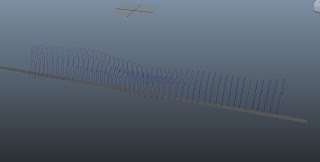Moving forward towards creating a surface that will relate to the video and my previous animation, I started by taking snapshots of the video at the points where I had originally diagrammed them for my first animation. Here you see 10 shots arranged on artboards in Illustrator. Image below:
Then I paid particular attention to the hierarchy of the visual representation of each frame, this time noticing the red cape as the most prominent feature of color throughout the scene. So I drew vector paths over the cape forms to create a set of base geometries that could start to inform my surface contours. I also drew over dark spots in each frame, provided mainly by the body figures that King Leonidas is approaching with each stride; however, I ended up abandoning those forms and looking at just the cape:
So, working still in Illustrator, I took the corresponding cape geometries from each scene and laid them out independently, spaced them evenly and blended them to create intermediate geometries for transition:
Finally, I went into Maya and started to take each of these pieces to fabricate my surface. The way I wanted to do this was to treat each piece as a cross section of a lofted surface, so that the contours of each piece start to form the combined piece. Here's a couple shots of the workspace:
And, ultimately, some rendered views of the resultant form:
This piece is particularly interesting; although the form was continuous and the cross sections lined up consistently, there was a hiccup along the line where certain contours cross into each other. This might be the way for me to incorporate the "pulse" motif that was discussed last class. I will start thinking about how to move along the surface and "film" it.
An interior view of the surface, "tunnel vision."









